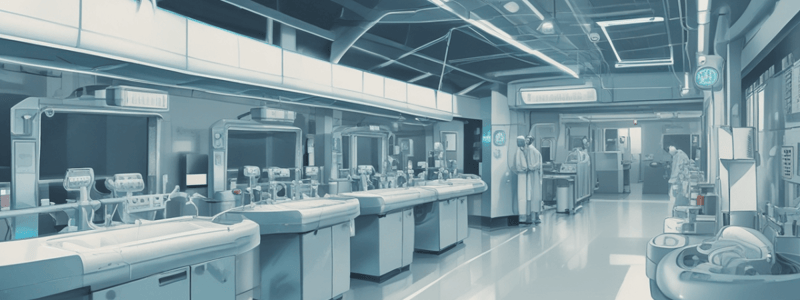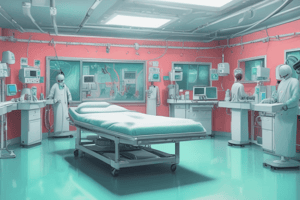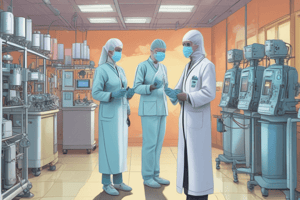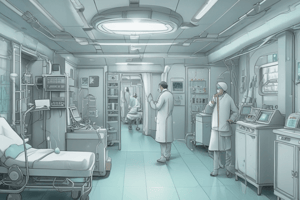Podcast
Questions and Answers
What is the primary goal of sterilization in medical devices?
What is the primary goal of sterilization in medical devices?
- To reduce the number of microorganisms on a surface
- To completely destroy all microorganisms including bacterial spores (correct)
- To sanitize medical devices before use
- To disinfect all reusable medical devices
What is a characteristic of ideal sterilization methods?
What is a characteristic of ideal sterilization methods?
- They require long cycle times to ensure effectiveness
- They have rapid throughput and are easily validated (correct)
- They are only used for non-invasive medical devices
- They are capable of processing unwrapped items only
Which sterilization method uses low temperature and normal pressure?
Which sterilization method uses low temperature and normal pressure?
- Ethylene Oxide (EO)
- Dry Heat (correct)
- Gas plasma
- Steam (moist heat)
What is the approximate cycle time for steam sterilization?
What is the approximate cycle time for steam sterilization?
Why is it necessary to sterilize all reusable invasive medical devices (RMD)?
Why is it necessary to sterilize all reusable invasive medical devices (RMD)?
What is the primary purpose of sterilization in the context of reusable invasive medical devices?
What is the primary purpose of sterilization in the context of reusable invasive medical devices?
Which of the following sterilization methods does not use heat?
Which of the following sterilization methods does not use heat?
What is a common constraint of steam sterilization?
What is a common constraint of steam sterilization?
What is an important consideration for sterilization methods in terms of storage?
What is an important consideration for sterilization methods in terms of storage?
Which of the following is a key benefit of gas plasma sterilization?
Which of the following is a key benefit of gas plasma sterilization?
What is a key difference between steam sterilization and dry heat sterilization?
What is a key difference between steam sterilization and dry heat sterilization?
Which of the following sterilization methods is capable of processing wrapped items?
Which of the following sterilization methods is capable of processing wrapped items?
What is a common factor among all ideal sterilization methods?
What is a common factor among all ideal sterilization methods?
Which of the following is NOT a characteristic of ideal sterilization methods?
Which of the following is NOT a characteristic of ideal sterilization methods?
What is the primary reason for sterilizing reusable invasive medical devices (RMD)?
What is the primary reason for sterilizing reusable invasive medical devices (RMD)?
What is a key advantage of sterilization methods that utilize low temperature chemical processes?
What is a key advantage of sterilization methods that utilize low temperature chemical processes?
Which sterilization method is most similar to a conventional oven?
Which sterilization method is most similar to a conventional oven?
What is a common limitation of thermal energy sterilization methods?
What is a common limitation of thermal energy sterilization methods?
What is a key factor in selecting a sterilization method?
What is a key factor in selecting a sterilization method?
What is a common benefit of sterilization methods that can process wrapped items?
What is a common benefit of sterilization methods that can process wrapped items?
Flashcards are hidden until you start studying
Study Notes
Sterilization Definition and Requirements
- Sterilization is the complete destruction of microorganisms, including bacterial spores.
- This level of decontamination is required for all reusable invasive medical devices (RMD).
Ideal Sterilization Methods
- Have rapid throughput
- Are easily validated
- Are capable of processing wrapped items to enable storage after processing without the risk of environmental contamination of processed items.
Sterilization Methods
- Steam (moist heat) at high pressure:
- Cycle time: approximately 40-60 minutes
- Dry Heat:
- Similar to an oven
- Uses normal pressure
- Cycle time: up to 2 hours
- Gas Plasma:
- At ambient temperature
- Cycle time: 45-75 minutes
- Ethylene Oxide (EO):
- At sub-atmospheric or high pressure
- Low Temperature Steam and Formaldehyde Vapor:
- Cycle time: not specified
Sterilization Definition and Requirements
- Sterilization is the complete destruction of microorganisms, including bacterial spores.
- This level of decontamination is required for all reusable invasive medical devices (RMD).
Ideal Sterilization Methods
- Have rapid throughput
- Are easily validated
- Are capable of processing wrapped items to enable storage after processing without the risk of environmental contamination of processed items.
Sterilization Methods
- Steam (moist heat) at high pressure:
- Cycle time: approximately 40-60 minutes
- Dry Heat:
- Similar to an oven
- Uses normal pressure
- Cycle time: up to 2 hours
- Gas Plasma:
- At ambient temperature
- Cycle time: 45-75 minutes
- Ethylene Oxide (EO):
- At sub-atmospheric or high pressure
- Low Temperature Steam and Formaldehyde Vapor:
- Cycle time: not specified
Sterilization Definition and Requirements
- Sterilization is the complete destruction of microorganisms, including bacterial spores.
- This level of decontamination is required for all reusable invasive medical devices (RMD).
Ideal Sterilization Methods
- Have rapid throughput
- Are easily validated
- Are capable of processing wrapped items to enable storage after processing without the risk of environmental contamination of processed items.
Sterilization Methods
- Steam (moist heat) at high pressure:
- Cycle time: approximately 40-60 minutes
- Dry Heat:
- Similar to an oven
- Uses normal pressure
- Cycle time: up to 2 hours
- Gas Plasma:
- At ambient temperature
- Cycle time: 45-75 minutes
- Ethylene Oxide (EO):
- At sub-atmospheric or high pressure
- Low Temperature Steam and Formaldehyde Vapor:
- Cycle time: not specified
Sterilization Definition and Requirements
- Sterilization is the complete destruction of microorganisms, including bacterial spores.
- This level of decontamination is required for all reusable invasive medical devices (RMD).
Ideal Sterilization Methods
- Have rapid throughput
- Are easily validated
- Are capable of processing wrapped items to enable storage after processing without the risk of environmental contamination of processed items.
Sterilization Methods
- Steam (moist heat) at high pressure:
- Cycle time: approximately 40-60 minutes
- Dry Heat:
- Similar to an oven
- Uses normal pressure
- Cycle time: up to 2 hours
- Gas Plasma:
- At ambient temperature
- Cycle time: 45-75 minutes
- Ethylene Oxide (EO):
- At sub-atmospheric or high pressure
- Low Temperature Steam and Formaldehyde Vapor:
- Cycle time: not specified
Studying That Suits You
Use AI to generate personalized quizzes and flashcards to suit your learning preferences.




